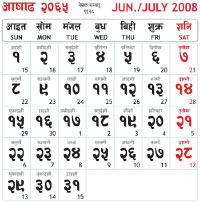The lunar calendar Nepal Sambat (Nepal Bhasa: नेपाल सम्बत) is commonly used in the Kathmandu valley of Nepal. It is believed that in the reign of King Raghav Dev of Kathmandu, it was initiated by Sankhadhar Sakhwa to commemorate the pay back of all the debts of people living in Kathmandu, then known as "Ya." Local legend has it that he raised the funds through alchemy, turning the sand of the Bagmati river to gold dust. The Bikram Sambat is official calendar of Nepal. Gregorian calendar is also widely used due to it international acceptance and Nepal Sambat has its own special relevance for Newars living in Nepal. Nepal Sambat is one among few of the native calendars to Nepal.Most of others either passed over the time or only maintain existence in the religious calendars called Patro.

This calendar was widely used in official use during the Malla period in Kathmandu valley. After the unification of Nepal, Saka sambat took ground and later on, during the premiership of Chandra SJBR Bikram Sambat were recognized for official use. This calendar, Nepal sambat, is being revived, especially in Kathmandu valley, over the last 3 decades. Moreover, the calendar was widely used by Newars for cultural and religious purpose inside the Kathmandu because of its relation with festivals Jatra that are celebrated in Valley Contents
Nepal Samvat, a lunar calendar, is a variant of "saka sambat" a Hindu calendar with main difference being, Nepal sambat lags saka sambat by 802 years. It consists of 354 days per year due to the fact lunar month has 29 or 30 days based on the movement of the moon. So it necessitates a month adhik mas to be added every third year. This calendar came into being and into official use during the reign of king Raghabdev, immediately after the completion of the Saka Samvat 802 (on 20 October 879 AD). The year 804 was approaching within a year and according to legend, his decision was guided by his fear of number 804, that some people still believe, brings misfortune. People with traditional belief still try to escape with number 8 that comes together with 12 (in Nepali -ath barha). Doing math correctly,804 adds up to 12 and 804 means 8 along with 12.
Nepal Samvat is a unique calendar in the sense,all other calendars are named after some rulers or religious leaders. Nepal Samvat is the only calendar which is named after a country. This calendar is said to have been introduced by a common subject Shankhadhar Sakhwa by clearing on his own all debts owing to the state by the then subjects of Nepal. This calendar was in continuous official use in city states of Kathmandu valley and Banepa for 889 years, i.e., from 879 to 1769 AD. After conquering city states of Kathmandu valley,in 1769 AD, King Prithvi Narayan Shah discontinued official use of Nepal Samvat as it was primarily used only inside the valley of Kathmandu and after the unification, valley was only a small part of bigger Nepal. Instead Saka Samvat became de facto as well as de-jure calendar of whole country. In valley itself, Saka Samvat were widely used in official work alongside the Nepal Samba. In 1903 AD, Rana prime minister Chandra Shamsher replaced the Saka Samvat with the Bikram Samvat, a Lunisolar calendar, which is in use as the official calendar in Nepal till date. Since the founder of the Nepal Samvat, Sankhadhar Sakhwa has been recognized as a national hero of Nepal. Nepalese people especially, inside Kathmandu Valley,are also demanding to preserve as well as reintroduce the Nepal Samvat as Nepal's official calendar.
Year 2000 CE refers to year 1120 in Nepal Sambat, or 2057 in the official Bikram Sambat calendar.
Months
| Devanagari | Roman script | Corresponding Gregorian month |
|---|---|---|
| कछला | Kachha lā | November |
| थिंला | Thin lā | December |
| पोहेला | Pohe lā | January |
| सिल्ला | Sil lā | February |
| चिल्ला | Chil lā | March |
| चौला | Chau lā | April |
| बछला | Bachha lā | May |
| तछला | Tachha lā | June |
| दिल्ला | Dil lā | July |
| गुंला | Goon lā | August |
| ञंला | Yen lā | September |
| कौला | Kau lā | October |
